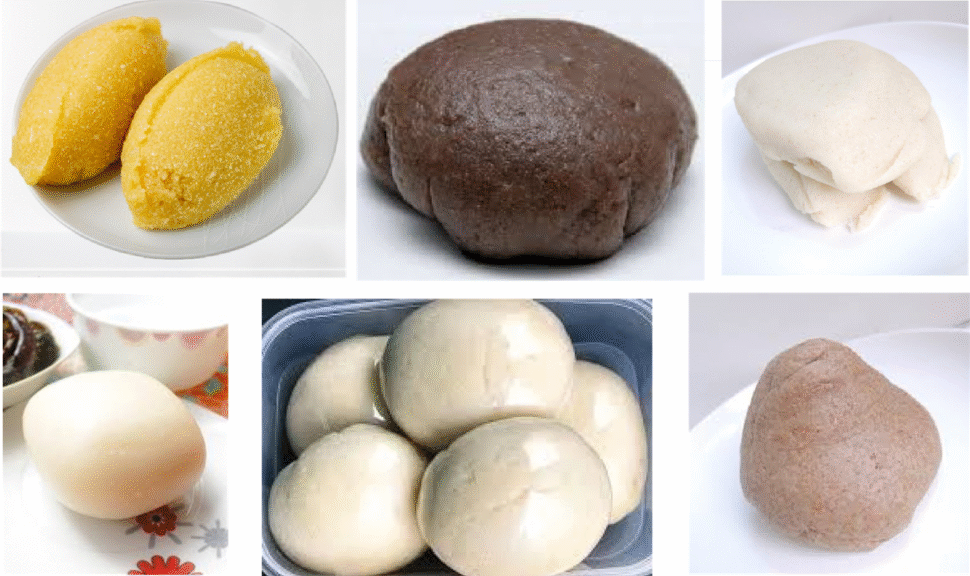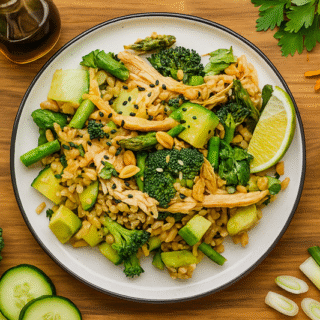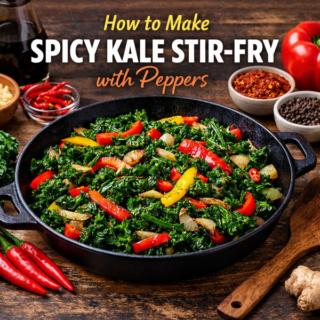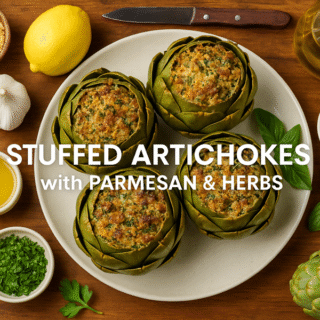Introduction
Nigerian swallows are the vibrant tapestry of flavours, textures, and traditions that reflect the diverse cultures of Nigeria↗. At the heart of many meals in Nigeria is a unique category of foods known as swallows, with a standout being the beloved “loi-loi.” Let us take you on a flavorful journey into the world of Nigerian swallow, exploring its significance, preparation methods, and the culinary delights it brings to the table.
Table of Contents
What are Swallows?
Swallows are a starchy dish that serves as a base for various soups and stews in Nigerian meals. They are typically enjoyed with hands, allowing for an intimate eating experience that connects diners to their food. Common types of swallows include pounded yam, fufu, ewedu, and, of course, loi-loi. Each swallow has its own distinct flavour, texture, and cultural significance, making them essential components of Nigerian dining.
Types of Nigerian Swallows
1. Pounded Yam (Nri Ji)
The pounded yam swallow is perhaps the most famous in Nigeria. It is made by boiling yam tubers until soft and then pounding them until they achieve a smooth, stretchy consistency. This dish has a creamy texture and pairs well with rich soups like egusi (melon seed soup), ogbono (wild mango seed soup), and efo riro (vegetable soup). Pounded yam is often a staple in special occasions and celebrations, showcasing its popularity and significance in Nigerian culture.
Preparation:
To prepare pounded yams, start by peeling fresh yams and cutting them into chunks. Then, boil the yam pieces in a pot of water until they are tender, which usually takes about 20 to 30 minutes. Once cooked, drain the yams and transfer them to a mortar and pestle or a sturdy mixing bowl. Use a pestle or a heavy tool to pound the yams until they become smooth and stretchy, adding a little hot water if necessary to achieve the desired consistency. Finally, mould the pounded yam into a soft, rounded shape and serve it warm with your choice of soups or stews.
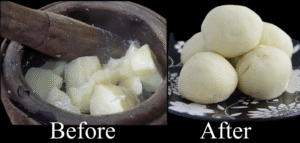
Pounded Yam before and after pounding.
2. Fufu (Akpu)
Fufu is a versatile swallow made from various starchy foods, primarily cassava. It is predominantly found in the southeastern part of Nigeria.
Preparation:
To make fufu, start by peeling fresh cassava and cutting it into manageable chunks. Then, soak the cassava chunks in water for about 3 to 4 days, changing the water daily to keep it fresh. After soaking, drain and rinse the cassava thoroughly to remove any impurities. Next, boil a pot of water and add the soaked cassava, cooking it until tender, which usually takes about 30 to 45 minutes.
Once cooked, drain the cassava and transfer it to a mortar and pestle or use a sturdy mixing bowl with a heavy tool to mash it until smooth and stretchy, adding a little water if needed to achieve the right consistency. After mashing, mould the fufu into small balls or a larger round shape, and serve it immediately with various soups, such as egusi, ogbono, or vegetable soup. Enjoy the unique dining experience of tearing off pieces with your hands to scoop up the soup.
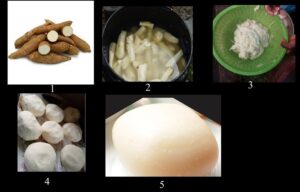
Fufu/Akpu preparation process.
3. Amala
Amala is a swallow made primarily from yam flour or cassava flour. There are different types of amala, including amala made from black tapioca (bobolo) or yam flour, giving it a dark brown hue. It has a unique, slightly earthy flavour and a smooth, stretchy texture. Amala is often served with ewedu, gbegiri (bean soup), or various meat-based soups. Its distinct colour and flavour make it a favourite among many Nigerians.
Preparation:
To prepare amala, measure 2 cups of yam flour and bring 4 cups of water to a boil in a pot. Reduce the heat to medium and gradually sprinkle in the yam flour while stirring with a wooden spatula to prevent lumps. Stir vigorously for about 5-10 minutes until smooth and elastic. Adjust the consistency by adding more water if too thick or more flour if too thin. After cooking, cover the pot for a few minutes to steam.
Scoop out portions and form them into balls or moulds. Serve hot with your favourite soups like egusi or efo riro, and enjoy with your hands. For added flavour, you can mix yam flour with cassava flour or use boiled and pounded fresh yams.

Amala before and after turning.
4. Semovita (Semovita) or Semolina
Semovita, often referred to as “semovita,” is made from semolina flour and water. The dough is cooked until it achieves a smooth, elastic consistency. Unlike pounded yam, semovita has a denser texture and is usually served with soups such as ogbono, egusi, or banga. Its ability to hold its shape makes it a popular choice for pairing with various stews.
Preparation:
To prepare semovita, start by bringing water to a boil in a pot, then gradually add semovita flour while stirring continuously to prevent lumps. Once the mixture thickens, reduce the heat, cover the pot, and allow it to steam for about 5-10 minutes. Then, fold and mix the semovita until it reaches a smooth consistency, add a little water if needed, and shape it into your desired form before serving it hot with your favourite soup.
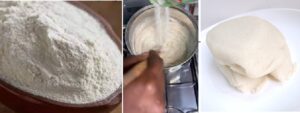
Semovita before and after turning.
5. Garri/Eba
Garri is a popular West African food made from cassava, a starchy tuber. It plays a significant role in the diets of many people in countries like Nigeria, Ghana, and Cameroon. The process of making garri involves peeling, soaking, fermenting, and then grating the cassava before it is roasted in a pan to become granulated.
Preparation:
To prepare garri, begin by peeling and washing fresh cassava tubers, then grate or pound the cassava into a smooth paste; after that, wrap the paste in a cloth to squeeze out excess water and let it ferment for about one to three days; once fermented, roast the squeezed cassava in a dry pan over medium heat, frequently stirring until it becomes dry and grainy. To prepare garri for soup, add boiling water and stir until a stiff dough forms. Then, serve alongside any Nigerian soup.
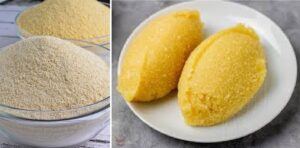
Garri before and after being turned in the hot water
6. Wheat
Wheatmeal is a light brown swallow derived from whole grain wheat milled into powder. Wheat swallow, also known simply as “swallow,” is a traditional dish made from wheat flour that is cherished in various cultures for its simplicity and versatility. The process of making wheat swallow is straightforward, making it a popular choice for many home cooks.
Preparation:
To make wheat swallow, start by mixing wheat flour with a pinch of salt in a bowl, then gradually add enough water to form a soft dough. Knead the dough for about 5-10 minutes until smooth and elastic, and let it rest for 30 minutes under a damp cloth. After resting, divide the dough into small balls and roll each one into a flat circle with a rolling pin. Heat a non-stick skillet over medium heat and cook each circle for 1-2 minutes on each side until golden and puffed. Finally, keep the cooked swallows warm by wrapping them in a clean cloth, and serve with your favourite soups or stews.
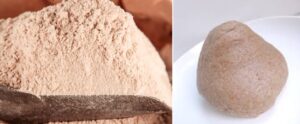
Wheat flour before and after being turned in the hot water.
- 25+ Delicious Kale Common Recipes That Will Transform Your Meals Forever 🌿✨
- How To Make Kale Stuffed Sweet Peppers: A Joyful, Powerful Healthy Delight🌿🫑
- How To Make Kale And Apple Slaw: A Joyful, Powerful Crunch You’ll Love 🥬🍎✨
- How To Make Delightful Ultimate Lemon Garlic Kale Pasta 🍋🧄🍝
- How To Make Kale And Bean Wraps – A Delicious Power-Packed Healthy Favorite 🌯💚
7. Tuwo Shinkafa
Tuwo Shinkafa is a traditional Nigerian dish, particularly popular among the Hausa people in northern Nigeria. Its origin can be traced back to Northern Nigeria, where rice farming has been a staple part of the culture and cuisine for centuries. The dish is primarily made from rice, specifically the long-grain variety, which is favoured for its texture when cooked.
Preparation:
The preparation begins with washing long-grain rice, which is then soaked in water for a few hours to soften it. After soaking, the rice is boiled in a large pot with water until it becomes soft and fully cooked. Once cooked, it is drained and transferred to a mortar and pounded with a pestle until it reaches a smooth, stretchy texture. It is usually shaped into balls and served alongside various soups or stews, such as miyan taushe, kuka, or any other Nigerian soups.
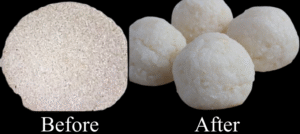
Tuwo Shinkafa can be served with any of the Nigerian soups.
8. Tuwo Masara
Tuwo Masara is a popular Nigerian dish made from cornmeal (maize flour) and is especially prevalent among the Northern ethnic groups of Nigeria. Its name translates to “corn dough” in Hausa, one of the major languages spoken in the region. The dish is made by mixing cornmeal with water and cooking it until it thickens to a smooth, pliable consistency, similar to that of a soft dough.
Preparation:
The preparation of Tuwo Masara typically involves boiling water and gradually adding the cornmeal while stirring to avoid lumps. Once cooked, it can be shaped into balls or served in a bowl, making it easy to enjoy with accompanying soups. This dish not only highlights the culinary traditions of Northern Nigeria but also reflects the region’s reliance on maize as a fundamental food resource. Any Nigerian Soup
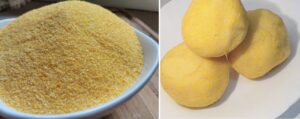
Tuwo Masara before and after.
9. Plantain Flour/Pounded unripe plantain
Plantain swallow is a popular dish in many West African countries, celebrated for its smooth texture and versatility in pairing with various soups and sauces. Made from dried and ground plantains, this flour serves as an excellent gluten-free alternative to traditional flours. Plantain swallow can also be made from pounded unripe plantains. Although both types come from unripe plantains, they have different tastes.
Preparation:
To prepare plantain flour swallow, you usually start by boiling water and gradually adding the flour while stirring continuously to avoid lumps. The mixture is then cooked until it reaches a stretchy, dough-like consistency. The final product is typically soft and pliable, making it perfect for enjoying with soups such as egusi, ogbono, or vegetable soups.
To prepare pounded unripe plantain, peel and slice firm, green plantains into chunks. Boil them in water for about 15-20 minutes until soft, then drain and let cool slightly. Pound the boiled plantains in a mortar and pestle or a bowl until smooth and stretchy. Shape them into balls or desired forms and serve hot with soups or stews like egusi or any of the Nigerian soups. Enjoy!

Pounded unripe plantain
Overall, plantain flour swallow stands out not only for its delightful taste and texture but also for its nutritional benefits, making it a staple in many households across West Africa.
10. Oat Swallow
Oat swallow is a nutritious and versatile dish that has gained considerable popularity as a healthy alternative to traditional swallows made from starchy staples like cassava or yam. This dish is made primarily from oats, which are rich in dietary fiber, protein, and essential vitamins and minerals.
Preparation:
To make oat swallow, start by boiling about 2 cups of water. Gradually add 1 cup of oat flour while stirring to prevent lumps, and cook until the mixture thickens and becomes smooth, about 3-5 minutes. If it’s too thick, add a bit more water. Knead the mixture until it’s elastic, then shape it into balls or pancakes. Serve with your favourite soups or stews.
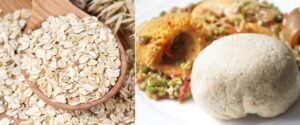
Oat swallow goes with any Nigerian soup
Other Swallows
The possibilities are endless. Some of the swallows mentioned earlier can be combined in various ways. For example, you can mix cassava and corn flour, cassava and plantain, or oat and wheat flour to create different swallows. Feel free to get creative with your combinations based on your personal preferences.
Some vegetarians have recently been able to use vegetables to make swallow-like dishes. Examples include:
- • Eggplant
- • Cauliflower
- • Cabbagege
Other types of swallow, aka loi-loi include;
-
Starch (Usi): Starch, commonly known as Usi, is made from wet cassava starch and is usually sold in a compact form similar to Pap.
-
Kpukpuru: Kpukpuru is a traditional fermented corn dish enjoyed in various regions, particularly the riverine areas of Ondo State, for its unique flavor and texture. Let me know if you need more information!
-
Potato Swallow: Potato swallow is a tasty twist on traditional swallow dishes. It is made from boiled and mashed potatoes, which make a flexible base for different kinds of soups.
- Cocoyam Swallow (Nri ede): Cocoyam swallow is a nutritious and versatile dish that serves as an excellent alternative to traditional swallows made from flours like cassava or yam. Cocoyam, also known as taro, has a creamy texture when cooked, which makes it perfect for creating a smooth swallow.

